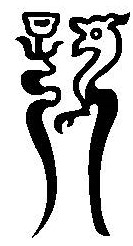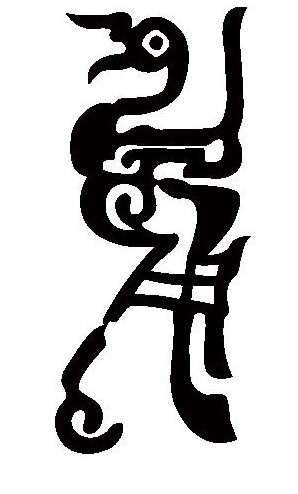Song Period (960–1279) Discoveries
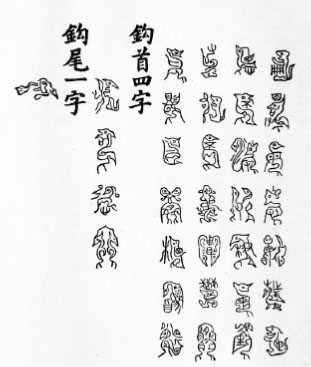
| | Daigou (belt buckle) inscription from the Xiaotang jigu lu (Wang Qiu, Xiaotang jigu lu, 69a-b [143-4]). |
1. Belthook (帶鉤 dàigōu) with inscription written in bird script 鳥篆箴言帶鉤
Discovered in the Song period. Now Lost. Description with facsimile of the inscription printed in Xue Shanggong 薛尚功, ed., Lidai zhongding yiqi kuanzhi fatie 歷代鐘鼎彝器款識法帖 (1144), 1.1 (p. 1-2) and Wang Qiu 王俅 (12th century), ed., Xiaotang jigu lu 嘯堂集古錄 (1176) 216b-217a. Rong Geng (1934) used the facsimile from Wang Qiu.
Name of Artifact Used in Previous Studies:
夏器款識, Xue Shanggong 薛尚功 (1144), 1.1 (p. 1-2).
帶鉤 Wang Qiu 王俅 (1176), 69a-b [143-4].
册□帶鈎, Rong Geng 容庚 (1934), 197-8; illus. #2
册□帶鈎, Rong Geng 容庚 (1964), 292-3; 318, illus. #39
鳥書箴言帶鈎, Zhang Guangyu 張光裕 and Cao Jinyan 曹錦炎 (1994), #125, 291.
鳥書箴銘帶鉤, Li Ling 李零 (1998), “Zhanguo niaoshu zhenming daigou kaoshi” 戰國鳥書箴銘帶鉤考釋, Li Ling zixuanji 李零自選集. (Guangxi: shifan daxue chubanshe 廣西師範大學出版社, 1998), 273 –277.
鳥篆箴言帶鉤, Shi Xiejie 施謝捷 (1998), #41, 539
鳥書箴言帶鈎 (夏帶鈎), Lin Chin-Chung 林進忠 (2007), 24, #125
箴銘帶鉤, Cao Jinyan 曹錦炎 (2014), 國別待考器 #30, 497 and 390, illus #502.
鳥書箴言帶鉤, Dong Shan 董珊 (2014), #41, 33n3.
鳥書箴銘帶鉤, Chen Li 陳立 (2019), “Cong niaoshu de shuxie cengmian xilun 'niaoshu zhenming daigou' de Guobie yu shidai” 從鳥書的書寫層面析論〈鳥書箴銘帶鉤〉的國別與時代, Di 29 jie Zhongguo wenzixue guoji xueshu yantaohui 第29屆中國文字學國際學術研討會 (2019): 225-248.
Inscription (33 characters with gold inlay):
1)Xue Shanggong attempts to transliterate a few of the characters and comments on the inscription:
右鉤帶銘三十三字鈿紫金為文不可盡識龍虎蟲鳥書也庾肩吾書品論曰魚猶捨鳳鳥已分蟲仁義起于麒麟威刑發于龍虎盖此類也肩吾雖稽古,
而為此說乃未之見也鈿金為篆實出邃古張懷瓘書録云往在翰林見古銅鐘二枚高二尺許有古文三百餘字紀夏禹功績字皆紫金鈿似大篆神采驚人盖虞夏之時乃有此字也
The inscription from a belt buckle (daigou) to the right is 33 characters long. The characters, inlaid with purple gold, which are not fully intelligible,
are written with dragons, tigers, insects, and birds. In the Shupin (Classification of Calligraphy), Yu Jianyu wrote,
“Fish (form) is distinguished from phoenix (form); bird (form) is differentiated from insect (form); benevolence and righteousness
rise out of the Qilin, and awe-inspiring punishments come from dragon and tigers.” Presumably, he is referring to this kind of writing.
Although Jianyu’s description is based on his study of antiquity, he had never seen such a thing.
Inlaid gold characters are a seal script that comes from remote antiquity.
Zhang Huaiguan 張懷瓘 (Tang) wrote in the Shulu (Catalogue of Two Wang's Calligraphy): “Formerly, when I was in Hanlin (academy), I saw two ancient bells that were approximately 2 chi high and had over 300 ancient characters recording the achievements of Yu of Xia,
All the characters were purple gold inlaid like great seal characters, which was just amazing.
Presumably, they used this kind of character in the time of Yu (Shun) and the Xia (Xue Shanggong, Lidai zhongding yiqi kuanzhi fatie, 2-3).
2) Wang Qiu (69a-b [143-4]) says the inscription is unreadable.
3) Li Ling (1998): [鉤首]勿(物)可悊(折)冬(中)/ [鉤腹]冊复毋反,毋囗(怍)毋𢘓(悔),不汲於利。民產(生)有茍(敬),不擇貴囗(賤)。宜曲則曲,宜植(直)則直。/ [鉤尾]允。
4) Shi (1999): 册复(復)母(毋)及。母(毋-無)怍母(毋-無)/ 𢘓(悔),不汲於利。民產/ 又(有)敬,不𢍰(擇)貴戔賤。宜/匚(曲)則匚(曲),宜植(直)則直/ 允。
5) Cao (2014): 册复(復)母(毋)反, 母(毋) [扌+(乍over土)] 作母(毋)/悔,不汲於利。民產/ 又(有) 苟(敬),不擇貴戔賤。宜/ 匕(曲)則匕(曲),宜植(直)則直/ 勿可[(二+斤)over心](折)冬(中)/ 允。
6) Dong Shan (2014): 删复(復)母(毋)反(繁), 母(毋) [扌+(乍over土)] 作母(毋)[毋over心](悔),不汲於利。民產又(有) 苟(敬),不擇貴戔賤。宜匕(曲)則匕(曲),宜植(直)則直·勿可[(斤+斤)over心](折)終·允。
|
|
This bell, which is now lost, was unearthed in the Song period. It was once in the collection of Zhao Zhongyuan 趙仲爰 (1054-1123), a member of the royal family. Later it was in the Song Imperial treasury.
Six Facsimiles of the Inscription:
1. Bell of King Zhezhi Yuyi of Yue 越王者旨於睗鐘 (Bogu tulu facsimile)
2. Bell of King Zhezhi Yuyi of Yue 越王者旨於睗鐘 (Xiaotang jigu lu facsimile, possibly taken from the Bogu tulu 博古圖錄, but slight variation).
3. Bell of King Zhezhi Yuyi of Yue 越王者旨於睗鐘 (Lidai facsimile #3, taken from Bogu lu 博古錄 but slightly varied)
4. Bell of King Zhezhi Yuyi of Yue 越王者旨於睗鐘 (Lidai facsimile #1)
5. Bell of King Zhezhi Yuyi of Yue 越王者旨於睗鐘 (Lidai facsimile #2)
6. Bell of King Zhezhi Yuyi of Yue 越王者旨於睗鐘 (Xiaotang jigu lu facsimile)
Description and facsimile printed in Wang Fu 王黼 (1079-1126), ed., Bogu tulu 博古圖錄 (1123), 22.16.
Description in Zhao Mingcheng 趙明誠 (1081–1129), Jinshilu 金石錄, 11.1.
Two facsimiles in Wang Qiu 王俅 (12th century), ed., Xiaotang jigu lu 嘯堂集古錄
(1176, p. 82a-b, possibly taken from the Bogu tulu 博古圖錄, but slight variation.
A second facsimile (p. 95) is unintelligible, with many characters missing.
Three facsimiles in Xue Shanggong 薛尚功, ed., Lidai zhongding yiqi kuanzhi fatie 歷代鐘鼎彝器款識法帖 (1144):
Facsimile #1 (1.2, p. 3-4) is taken from Huaiyang shiben 淮揚石本. Facsimile #2 (1.3, p. 5-6), facsimile taken from Guqiwuming 古器物銘.
Facsimile #3 (1.4, p. 6-7) is taken from the Bogu lu 博古錄, but is slightly different, actually each edition of the Lidai zhongding yiqi kuanzhi fatie
has slight variations.
Rong Geng容庚 (1934, 196-197) uses the inscription from Lidai zhongding yiqi kuanzhi fatie facsimile #1, but has the picture of the bell from the Bogu tulu.
The bell is described as a “Zhou Bell with Jiao-dragon Script” 周蛟篆鐘by Wang Fu 王黼 (1079-1126) in the Bogu tulu 博古圖錄 (1123)
and Wang Qiu 王俅 (12th century) in the Xiaotang jigu lu 嘯堂集古錄, or a “Shang Bell” 商鐘 by Xue Shanggong 薛尚功 in the Lidai zhongding yiqi kuanzhi fatie 歷代鐘鼎彝器款識法帖 (1144). Zhao Mingcheng 趙明誠 (1081–1129) in the Jinshilu金石錄 calls it in an “Ancient Bell” 古鐘.
Shanggong 薛尚功 has three facsimiles of the bell from three different sources (one being the Bogu tulu). Zhao Mingcheng 趙明誠(1081–1129),
includes a description of the bell in his Jinshilu 金石錄. The Xiaotang jigu lu 嘯堂集古錄 (1176) by Wang Qiu 王俅 (12th century)
also has a similar facsimile, apparently taken from the Bogu lu 博古錄, but with slight variations. Also in the Xiaotang jigu lu,
there is another facsimile of a bell called a “Shang Bell” 商鐘, based on our modern understanding of the inscription,
it might be the same bell as above, but transcribed in a rather confused manner.
Commentary on Inscription:
Xue Shanggong, Lidai zhongding yiqi kuanzhi fatie, 7:
銘五十二字字極古間作鸞鶴蛟螭之形其銘不可辨識者…昔張懐瓘在翰林時,見古鍾紀夏禹之績,皆紫金,鈿以大篆,神彩驚人此鍾欵識盖亦鈿金篆也.
The inscription is 52 characters long, and the exceptionally ancient characters, which are occasionally written in the shape of phoenixes, cranes, jiao-dragons, and chi-dragons, and cannot be recognized…In the past, when Zhang Huaiguan 張懷瓘 (Tang) was in the Hanlin (academy), he saw an ancient bell recording the achievements of Yu of Xia. All the characters were great seal characters inlaid with purple gold, which amazed everyone. This bell’s inscription is also presumably inlaid purple gold seal characters.
Inscription:
Bogu tulu (1123): 隹正月仲/春吉日丁/亥既望分/召純釐擇/乃吉金自/欣和其安/以樂
娛奉/喜而賓客/其怡鼓之/夙暮不忘/烏余子孫/萬葉無疆/用之勿相
Xue Shanggong (1144) #1: 隹正月王/春吉日丁/亥既望/分召純/釐擇乃/吉金自/欣
和其/安以樂/娛奉喜而/賓客其怡/鼓之夙/暮不貣/焉余子/孫萬葉/無疆用/之勿相
Xue Shanggong (1144) #3: 隹正月王/春吉日丁/亥既望分/召純釐擇/乃吉金自/欣
和其安/以樂娛奉/喜而賓客/其怡鼓之/夙暮不貣/焉余子孫/萬葉無疆/用之勿相
Wang Qiu 王俅 (12th century): 隹正月仲/春吉日丁/亥 o o 噱/ 召 o o 擇/乃吉金樂/欣禾
其 o ,我台樂 o o /喜而賓客/ o 台鼓之/夙暮辛 o /烏余子孫/萬世無疆/用之協相
Ma Chengyuan (1986-90): 隹正月王/ 囗 (春)吉日丁亥, 戉(越)王/者旨於/賜𢍰 (擇) 氒/吉金自/台(以)樂/, 而/賓客, 其台(以)/鼓之, 夙/莫(暮)不貣。/順(訓)余子/孫,萬枼(世)/亡疆,用/之勿相(喪)。
Jicheng (Chant.org): 隹正月季春。吉日丁亥。戉王者旨於賜擇厥吉金。自乍禾翟。台樂可
康。嘉而賓客。日日台鼓之。𡖊暮不貣。順余子孫。萬枼亡疆。用之勿相。
Shi (1998)#98-99:隹正月旁/春吉日丁/亥戉王/者旨於/賜𢍰氒/吉金自/乍禾㐭/我台樂/丂帝⧄而/賓客日台/鼓之夙/莫不寶/順余子/孫萬枼/亡疆用/之勿相
Cao (1994A): 隹(唯)正月季/春吉日丁/亥,戉(越)王/者旨於/賜擇氒 (厥)/吉金,自/乍(作)禾(龢) 童(鐘) 。 /我台(以)樂/丂(考) 、帝(嫡)、 [祖over口] (祖)、夫、/賓客,日台(以)/鼓之, 夙/莫(暮)不貣(忒)。/順余子/孫,萬枼(世)/亡疆,用/之勿相(喪)。
Shi#100 (1998):隹正月旁/春吉日丁/亥戉王者/旨於賜𢍰/ 氒吉金自/乍禾㐭我/台樂丂帝/⧄而賓客/日台鼓之/夙莫不寶/順余子孫/萬枼亡疆/用之勿相
Cao Jinyan (2014): 隹(唯)正月季/春吉日丁/亥,戉(越)王/者(諸)旨(稽)於/賜擇氒 (厥)/吉金,自/乍(作)禾(龢) 童(鐘) 。 /我台(以)樂/丂(考) 、帝(嫡)、 [祖over口] (祖)、夫、/賓客,日台(以)/鼓之, 夙/莫(暮)不貣(忒)。/順余子/孫,萬枼(世)/亡(無)疆,用/之勿相(喪)。
Dong Shan (2014): 隹(唯)正月季囗(春)吉日丁亥, 戉(越)王者旨於賜擇 氒(厥)吉金,自乍(作)禾(龢) 童(鐘) 。 我台(以)樂丂(考) 、帝(嫡)、 [且over口+戈] (祖)、夫(大夫)、賓各(客),日台(以)鼓之, 夙莫(暮)不貣(忒)。順(訓)余子孫,萬枼(世)亡(無)疆,用之勿相(喪)。
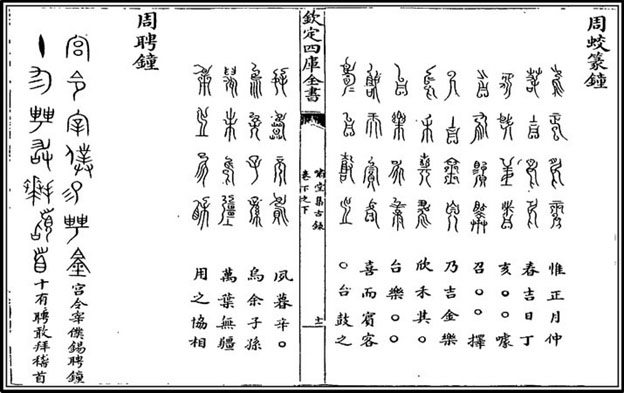
| | Wang Qiu 王俅 (12th century), ed., Xiaotang jigu lu 嘯堂集古錄 (1176, p. 82a-b). |
|
Discovered in the Song period. Now lost. Originally in the Collection of Dong Wuzi 董武子 (d. 1137). Described with facsimile in Xue Shanggong 薛尚功, ed., Lidai zhongding yiqi kuanzhi fatie 歷代鐘鼎彝器款識法帖 (1144), 1.4-5 (p. 8).
Name of Artifact Used in Previous Studies:
商鐘四 Xue Shanggong 薛尚功, ed., Lidai zhongding yiqi kuanzhi fatie 歷代鐘鼎彝器款識法帖 (1144), 1.4-5 (p. 8).
之利鐘, Jicheng 集成, 1.171.
朱句鐘, Zhang Guangyu 張光裕 and Cao Jinyan 曹錦炎 (1994), #103, 268.
朱句鐘, Cao Jinyan 曹錦炎 (1996), 61-64.
朱句鐘, Shi (1998), #102, 559-60.
朱句鐘(商鐘), Lin Chin-Chung 林進忠 (2007), 20, #103.
越王朱句鐘, Cao Jinyan 曹錦炎 (2014), 287-88; 290, illus #252.
越王州句劍, Dong Shan 董珊 (2014), #194, 87-88.
Inscription:
Xue Shanggong:
惟王夾鐘春吉月子/昭鈴鼓之敷受 [糹+絲over正]( 繼)命/九州喜悦既擇吉金/用召和欣怡樂賓客/於赫純魯侯望 [䏍+长](能)全/之格韻孔協萬年之/後世【闕】自安烏余同/汝之利元孫以介眉壽
Jicheng (Chant.org): 隹王正月。初吉乙巳。□朱句之利孫。乍□王欲复師阤。擇吉金。自乍禾鐘。台樂賓客。志勞尃者𥎦。往矣。余之客。酓子利。萬世之後。亡疾自下□余同女。之利台孫。其永寶。
Cao (1994): 隹(唯)王正月初吉乙子(巳),/ □朱句之利孫(?)□亘□/喪。王欲复(復)師,擇吉金/自乍(作)禾(龢) 童(鐘)。台(以)樂賓客,/志(誌)勞尃(賻)者(諸)侯。 [止over 土](往) 已! 余/之客,酓=孔協, 萬枼(世)之/後, 亡疾自下, /允立(位), 同/女(汝)之利。台(嗣)孫皆永寶。
Shi (1998): 隹(唯)王正月初吉乙子(巳), /⧄朱句之⧄⧄亘⧄/喪⧄⧄复(復) ⧄, 𢍰(擇)吉金,/白(自)乍(作)禾(龢)㐭(林)。台(以)樂賓客,/志勞尃(賻)者(諸)侯。[山over 主]( (往) ⧄余/之各(客)酓(㱃) ⧄⧄, 萬枼(世)之/後, ⧄⧄白(自) 宁(定), 四啚(鄙)同/安。之⧄⧄⧄⧄⧄⧄。
Cao (2014): 隹(唯)王正月初吉乙子(巳), /□朱句之利孫(?)□亘□/喪。王欲(?)复(復)師。擇吉金,/自乍(作)禾(龢) 童(鐘)。台(以)樂賓客,/志(誌)勞尃(賻)者(諸)侯。 [止over 土](往) 已! 余/之客。酓[=](酓酓) 孔協, 萬枼(世)之/
後, 亡(無)疾自下, 允立(位), 同/女(安)之利。台(嗣)孫皆永寶。
Dong Shan (2014): 隹(唯)王正甬屯吉乙子(巳),□□句之□□亘□喪□□複(復)□, 擇吉金,自
乍(作)禾(龢)㐭(林)。台(以)樂賓客,志勞尃(賻)者(諸)侯,往□余之各(客)酓□□, 萬枼(世)之後,□□ 自寧,四啚(鄙)同安。之□□□□□□。
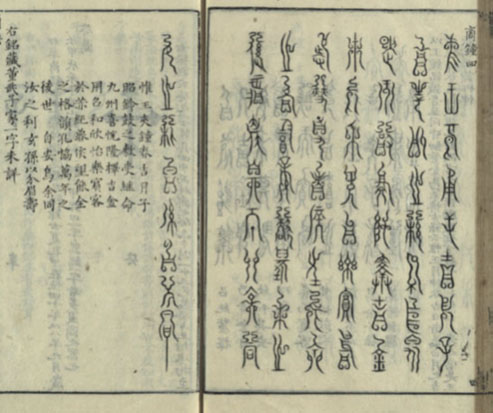
| | Xue Shanggong 薛尚功, ed., Lidai zhongding yiqi kuanzhi fatie 歷代鐘鼎彝器款識法帖 (1144), 1.4-5 (p. 8). |
|
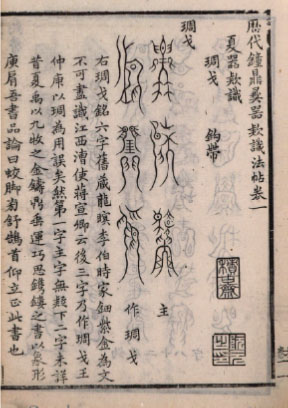
| | Xue Shanggong 薛尚功, ed., Lidai zhongding yiqi kuanzhi fatie 歷代鐘鼎彝器款識法帖 (1144), 1a. |
1) Lü Dalin's 呂大臨 (1044-1091) Kaogutu 考古圖,
2) Described with facsimile in Xue Shanggong 薛尚功, ed., Lidai zhongding yiqi kuanzhi fatie 歷代鐘鼎彝器款識法帖 (1144), 1a.
3) 作用戈, Rong Geng (1934), 198, illus #3.
4) 蔡侯產戈二, Cao Jinyan 曹錦炎 (2014), 295 (Cai #4); 298, illus. #257.
Commentary on Inscription:
Lü Dalin 呂大臨, Kaogutu 考古圖, Siku Quanshu, 6.45:
胡有銘六字, 蟲鳥書黃金文...王莽時, 甄豐文字部,六曰蟲鳥書,以題幡信晉王愔文字志亦有蟲書象形張懐瓘書録云往在翰林見古鐘二枚髙二尺許有古文三百餘字紀夏禹功
績皆紫金鈿似大篆神彩驚人蓋三代鈿金為篆其精類如此
The hu (part of a dagger-axe) has an inscription in six characters in yellow gold written
with insects and birds...In the time of Wang Mang, Zhen Feng (d. 10 CE) checked the different categories of characters,
the 6th one was called insect and bird script, which was used to write on banners with credentials.
Wang Yin of the Jin period in his book Wenzizhi also has pictographs in insect script. Zhang Huaiguan in Shulu says,
Previously, when I was in the Hanlin academy I saw two ancient bells that were about two feet tall, and had inscriptions with
more than 300 characters that were like great seal characters, inlaid with purple gold, recording the achievements of Yu of Xia, just amazing.
Presumably these are excellent specimens of Three Dynasties gold inlaid seal characters.
Xue Shanggong 薛尚功, ed., Lidai zhongding yiqi kuanzhi fatie 歷代鐘鼎彝器款識法帖 (1144), 1a.:
鈿紫金為文不可盡識江西漕使蔣宣卿云後三字乃作琱戈王仲庚以琱為用誤矣然第 一 字主字無疑下二字未詳昔夏禹以九牧之金鑄鼎垂運巧思以鐫鏤之書以象形庾肩吾書品論曰
蚊脚旁舒鵠首仰立正此書也
The inscription, inlaid with purple-gold characters, is not fully intelligible. Jiang Xuanqing, the
caoshi (Official in charge of transporting grain on the water-ways) of Jiangxi, says the last three characters are zuo 作 (make), diao 琱
(carved), ge 戈 (dagger-axe). Wang Zhonggeng thinks the character diao is a mistake and should be the character yong 用 (use).
Furthermore, the first character is zhu 主 (master), there is no doubt about that,
but the following two characters are uncertain. In the past, Yu of Xia forged the bronze tripods with metal from the lords of nine regions.
With an eye for posterity, he cleverly engraved them with these pictographic characters. In the Shupin (Classification of Calligraphy),
Yu Jianyu wrote, “mosquito legs swooping down to the side, swans standing with heads looking up.” This is this very writing style.
Inscription:
Cai (2014): 蔡侯產/之用戈。
|
Qing Period (1644-1911) Discoveries
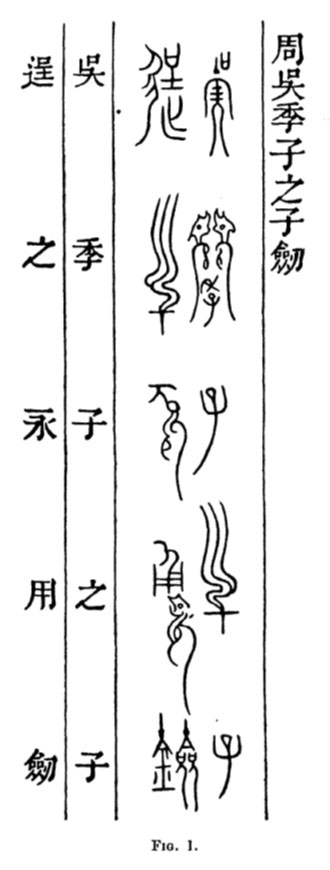
| | Inscription from Ruan Yuan 阮元 (1764~1849), Jiguzhai zhongding yiqi kuanshi 積古齋鐘鼎彝器款識 (1804), 8.20:. |
1669
1. Sword of the Cheng, the son of (Prince) Jizi of Wu 吳季子之子逞劍 (集成, 18.11640.)
Originally in the Collection of Sun Chengze 孫承澤 (1592-1676). Now Lost.
References:
吳季子之子永寶用劍, Wang Shizhen 王士禎 (王漁洋, 1634-1711) 雙劍行 (Written 1669; Collected in Yuyang shanren jinghua lu 漁洋山人精華録in 1700).
吳季子之子保之永用劔, Wang Shizhen, Chibei outan 池北偶談 (1701).
周吳季子之子劍, Ruan Yuan 阮元 (1764~1849), Jiguzhai zhongding yiqi kuanshi 積古齋鐘鼎彝器款識
Ancient Chinese Sword with “Bird Script,” Perceval Yetts (1934): Figure 1.
吳季子之子劍, Rong Geng (1934), 198, illus #4.
吳季子之子逞之劍, Rong Geng 容庚 (1964), 285-6; 304, illus. #19.
吳季子之子逞劍, Jicheng 集成, 18.11640.
吳季子之子逞之劍, Dong Chuping 董楚平 (1992), 98-99.
吳季子之子逞劍, Shi Xiejie 施謝捷 (1998), #46, 541.
吳季子之逞劍, Lin Chin-Chung 林進忠 (2007), 25. #135.
吳季子之子劍, Cao Jinyan 曹錦炎 (2014), 66.
吳季子之逞劍, Dong Shan 董珊 (2014), #15.
Inscription:
Ruan Yuan (1804):吳季子之子逞之永用劍
Jicheng (Chant.org): 吳季子之子逞之元用鐱。
Dong (1992): 吳季子之子/
逞之元用鐱。
Shi (1998): 吳季子之子/
逞之兀(元)用鐱(劍)。
Cao (2014): 吳季子之子/
逞之元用鐱(劍)。
Dongshan (2014): 吳季子之子逞之元用劍。
Commentary
Wang Shizhen 王士禎, Chibei outan 池北偶談 (1701):
孫北海(承澤)家藏三劍:其一銅劍,長尺餘,有鳥篆十字,雲「吳季子之子保之永用劍」,篆甚奇古。
In the collection of Sun Beihai (Sun Chengze) there are three swords, the first is more than a foot long, with 10 characters written in bird seal script, that says, “sword to be forever used by Bao, the son of Jizi of Wu,” 吳季子之子保之永用劍, the seal script are exceptional and ancient.
Ruan Yuan 阮元 (1764~1849), Jiguzhai zhongding yiqi kuanshi 積古齋鐘鼎彝器款識 (1804) 8.20:
周吳季子之子劍:
Inscription: 吳季子之子逞之永用劍
右周吳季子之子劍,劍銘十字鳥篆文據舊藏摹本編八,程易疇云:胡生得孫退谷所藏吳季子之子劍劍銘搨本(拓本),遂以遺余。其篆鳥蟲書十字二行,退谷手書釋之曰:“吳季子之子保之永用劍”;又為跋尾手書之,其略云:昔季子有劍,為徐君所愛,此則其子之劍。吾見三代諸器款識多矣,鮮有及此者。舊在睢陽袁氏曾向余言,買時一字酬以十金。余案《曝書亭集》,有孫少宰蟄室觀吳季子劍,四十韻聯句詩,又有延陵季子劍銘跋,其略云:康熙九年冬偕李良年潘耒蔡湘過退谷先生蟄室出延陵季子佩劍,相示以周,尺度之,長三尺臘廣二寸半,重九[金+(夕over 寸)](鉤?),上士之劍也。臘有銘篆文,不可辨,曰季子劍者,先生審定之辭云爾,據此則退谷初得是劍時,尚未能盡識其銘文,見有季子字,故以為季子劍,厥後十字盡識,乃知為季子之子劍也。朱氏言:臘有銘,以劍身為臘,仍注之誤。蓋臘與身其廣略同也。又案《精華錄》有雙劍行,孫退谷侍郎席上作是詩,作於康熙八年,在《曝書亭集》作劍銘跋之先,一年詩中但敘季子事,無一字及其子,可見是時王氏亦不知其為季子之子劍也。乃自注雙劍,則云其一魚腸,其一有銘云吳季子之子劍,此必因退谷既經辨識之後,改其自注以存寶錄。故池北偶談之作,遠在作雙劍行之後亦得詳載十字銘文,與退谷手書釋文無異,而其詩仍舊未暇改益,足徵其注之為改作矣。元案逞字吳侃叔所釋,蓋季子之子名,舊釋作造非也。
To the right is the Zhou Dynasty Sword of the Son of Jizi of Wu.
The Sword's inscription is 10 characters long written in Bird Seal Script reproduced from the eighth volume of facsimiles from the former collection.
Cheng Yichou 程易疇 (courtesy name of Cheng Yaotian 程瑤田, 1725-1814) said, “Mr. Hu (胡世琦) acquired the rubbing of the Sword of the Son of Jizi that was in the collection of Sun Tuigu (Sun Chengze) and gave it to me.
There are ten characters in two columns written in seal style bird and insect script.
Tuigu personally wrote it, transcribing it as saying “the Sword to be used forever by Bao, the Son of Jizi of Wu” 吳季子之子保之永用劍.
Moreover, a colophon, written in his own hand briefly says: Formerly, Jizi had a sword, which was loved by the Ruler of Xu.
This is his son’s sword. I’ve seen many inscriptions on a variety of bronzes from the Three Dynasties.
Very rarely do ones that match this. Formerly, Mr. Yuan of Suiyang told me when he bought it he spent 10 gold pieces of gold for each character.”
My Comment: The Pushu ting ji 曝書亭集 has Assistant Minister Sun’s poem in 40 rhymed couplets about appreciating
the Sword of Jizi in a secret room. Furthermore, it had a colophon of the inscription on the sword of Yanling Jizi which briefly said,
“In the winter of the 9th year of Kangxi, accompanied by Li Liangnian 李良年 (1635-1694), Pan Lei 潘耒 (1646年-1708) and Cai Xiangguo 蔡湘過,
Mr. (Sun) Tuigu took the Yanling Jizi personal sword out the secret room and showed it around and measured it.
It was three feet long and the blade was 2 ½ inches wide, and it was 9 gou/qiang heavy, it’s the sword of a high level noble.
The blade had an inscription in seal script which could not be clearly distinguished,
but the reason the “Sword of Jizi” was thrown around was because a certain gentleman examined it and said so.
Because of this, when (Sun) Tuigu originally acquired this sword, they still could not completely make out all the characters on the inscription,
but they saw the characters ji and zi, so, he thought it was the Sword of Jizi. After this, they were able to mke out all ten characters,
and finally knew it was the sword of the son of Jizi. Mr. Zhu says, “The blade has an inscription, considering the sword’s body is the blade, follows a mistake in the comment, perhaps the blade and body are about the same width.”
Another comment: “The Jinghualu 精華錄 has the poem “Lines on the Two Swords” 雙劍行, written in the 8th year of Kangxi.”
This poem, which was composed a year before the colophon about sword inscriptions in the Pushu ting ji 曝書亭集 was written,
only details Jizi’s story, but not a word about his son, so, you can see that at this time,
Wang Shizheng did not know that it was the sword of the son of Jizi. He himself annotated that the two swords (in the poem),
first referred to Fish Guts and the other has inscription says the Sword of the Son of Jizi. This must come after the time that (Sun) Tuigu had deciphered the inscription, and he himself changed his annotation in order to preserve this precious record. So, the Chibei outan was composed long after the poem “Shuangjianxing,” The Chibei was also able to record in detail the ten character inscription, which was not different than the explanation that Tuigu had written with his own hand, but the (Wang’s) poem was unchanged from before, this is enough evidence that his annotations had these changes. Yuan’s comment:
The character Cheng was figured out by Wu Dongfa 吳東發 (Kanshu 侃叔, 1747 – 1803), so, the previous reading that Zao was name of Jizi’s son is incorrect.
|
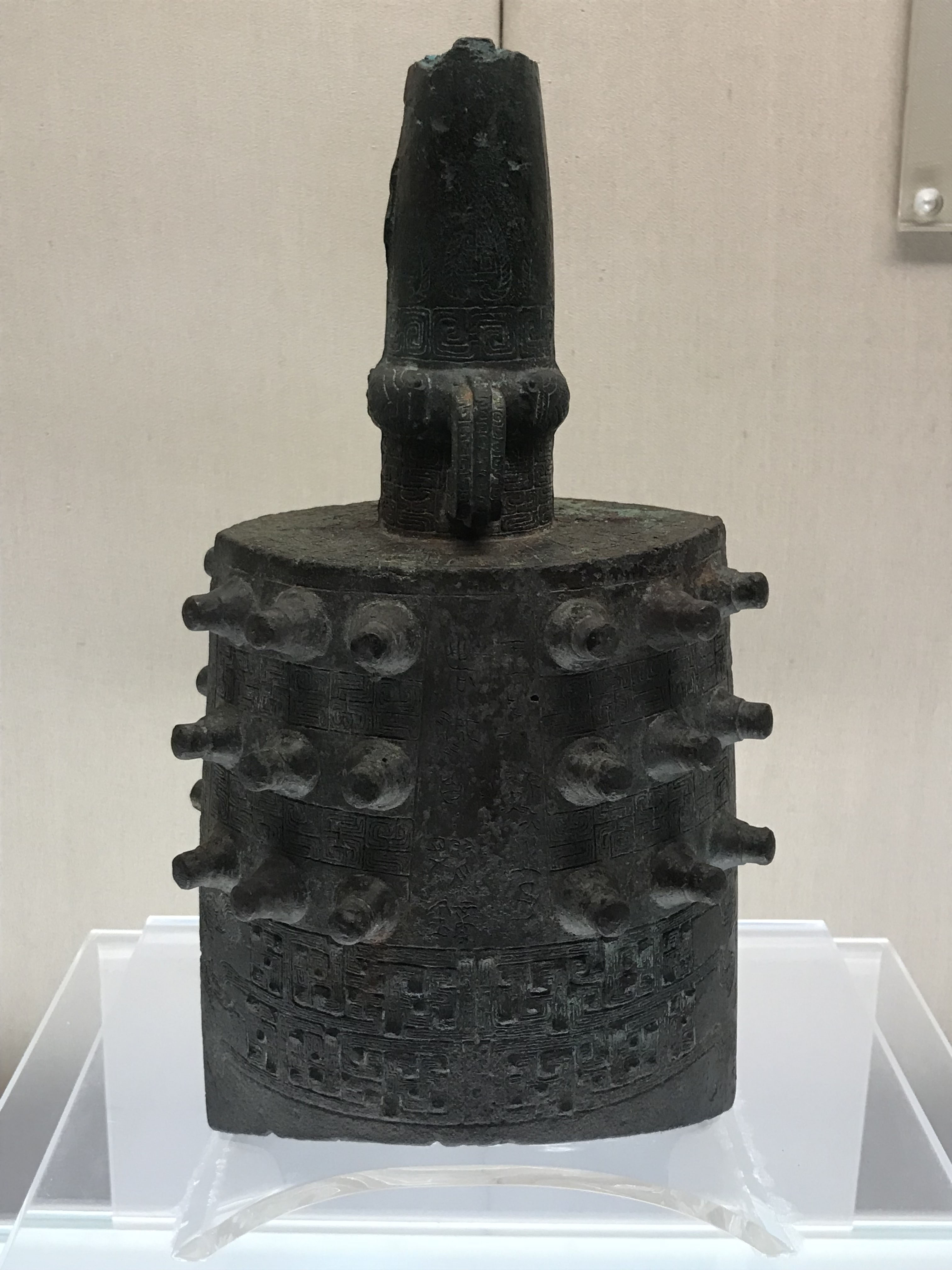
| | The Zhejian Bell in the Shanghai Museum. |
1761
The Bells of Prince Zhejian 者减鐘 of Wu
Discovered in 1761.
The Bells of Prince Zhejian 者减 of Wu were discovered in year 26 of Emperor Qianlong 乾隆 (1761) in Linjiang 臨江 (present-day Qingjiang County 清江縣, Jiangxi 江西 province) by some farmers digging in a field.
A set of eleven bells were found, of which four are extant today.
The imperial catalogue Xiqing xujian 西清續鑑 (1793): 17.5 describes these bells.
Six have long inscriptions of 83 characters and Four have short inscriptions of 28 characters, the smallest does not have an inscription.
The inscriptions says that the bells were made for Prince Zhejian 者减 of Wu, the son of a certain King Pi’nan of Wu 吳王皮難, whose position in the line of Wu kings is unknown. Ma Chengyuan and has tried to identify this king Pi’nan, and if he is earlier than Shoumeng, it indicates that the ruler of Wu may have already taken the title of king before their appearance in the records of the Central States, see, Olivia Milburn, The Spring and Autumn Annals of Master Yan (Brill, 2016), 147n85.
1. Bell of Prince Zhejian 者减鐘 (Jicheng 集成, 1.193).
Provenance: Qianlong 乾隆 year 26 (1761); Linjiang 臨江, Jiangxi (present-day Qingjiang County 清江縣)
Current Location: Whereabouts Unknown
Name of Artifact Used in Previous Studies:
者鐘, Jicheng 集成, 1.193.
者减鐘, Dong Chuping 董楚平 (1992), 26-39.
者减鐘一, Shi Xiejie 施謝捷 (1998), #1, 523.
Inscription:
Jicheng (Chant.org): 隹正月初吉丁亥。工䱷王皮〔㸐之〕子者□□□□□□□鐘。□□□不□不□。□于□□□□□龢□□□用□□□□□□□□□□皇□且□□□□公壽。□若參壽。□□□□□□倉□其□于□孫孫永□□□□
Shi (1998): 隹正月初吉丁亥工/䱷王皮□□子者/□□□□□□□鐘/□□□[羊over 牛]不□不□/□于□□□龢/□□用□□/□□[釐+子]□□皇/且□□□□公壽/若參壽□□□□=□=/□=倉=其□于□□□/□□□□孫=永=□□□
|
|
2. Bell of Prince Zhejian 者减鐘 (Jicheng 集成, 1.194).
Provenance: Qianlong 乾隆 year 26 (1761); Linjiang 臨江, Jiangxi (present-day Qingjiang County 清江縣)
Current Location: Whereabouts Unknown
Name of Artifact Used in Previous Studies:
者鐘, Jicheng 集成, 1.194.
者减鐘, Dong Chuping 董楚平 (1992), 26-39.
者减鐘二, Shi Xiejie 施謝捷 (1998), #2, 523.
Inscription:
Jicheng (Chant.org): 隹正月□□□□□䱷王□□□□者擇其吉金。自乍□□□□□□□□□不□□□于□□□□□□□□□壽□□其皇□□□□□□□□參□□。□□倉。□其登于□□子子孫孫。永保是尚。
Shi (1998): 隹正月□□□□□/䱷王□□□□者[減over皿]/ 𢍰其吉金自乍□□/□□□□□□不/□□于□□□□/□□□□釁壽/□□其皇□□□□□□/□□參□□□龢= [音+刀]=/□=倉=其登于□□□/□□□子=孫=永保是尚
|
|
3. Bell of Prince Zhejian 者减鐘 (Jicheng 集成, 1.195).
Provenance: Qianlong 乾隆 year 26 (1761); Linjiang 臨江, Jiangxi (present-day Qingjiang County 清江縣)
Current Location: Whereabouts Unknown
Name of Artifact Used in Previous Studies:
者鐘, Jicheng 集成, 1.195
者减鐘, Dong Chuping 董楚平 (1992), 26-39.
者减鐘二, Shi Xiejie 施謝捷 (1998), #3, 523.
Inscription:
Jicheng: 隹正月。初吉丁亥。工䱷王皮㸐之子。□睪其□□。□□□鐘。不帛□□□□□彫。□□□□□□。□龢卑□。用𣄨壽□。于其皇且皇考。若召公壽。□參壽卑女。龢龢倉倉。□其登于□□子子孫孫。永保是尚。
Shi (1998): 隹正月初吉丁亥工/䱷王皮㸐之子□[減over皿]/ 𢍰其□□□□□鐘/不帛□□□□□清/□□□□□□龢/卑□用𣄨釁壽□[釐+子]/于其皇且皇考若召/公壽□參壽卑女[龠+惠]=/[音+刀]=龢=倉=其登于□□□/□□□子=孫=永保是尚
|
|
4. Bell of Prince Zhejian 者减鐘 (Jicheng 集成, 1.196).
Provenance: Qianlong 乾隆 year 26 (1761); Linjiang 臨江, Jiangxi (present-day Qingjiang County 清江縣)
Current Location: Whereabouts Unknown
Name of Artifact Used in Previous Studies:
者鐘, Jicheng 集成, 1.196
者减鐘, Dong Chuping 董楚平 (1992), 26-39.
者减鐘二, Shi Xiejie 施謝捷 (1998), #4, 523-4.
Inscription:
Jicheng (Chant.org): 隹正月□吉□亥。工□王皮㸐□□。者其吉金。自乍□鐘。不帛不。不□不彫。于我□。卑龢卑□。用𣄨壽□。于其皇且皇考。□□□公壽。若參壽。卑□□。龢龢□□。□登于□□。子子孫孫。永□□尚。
Shi (1998): 隹正月□吉□亥工/王皮㸐□□者[減over皿]其吉/金自乍□鐘不帛不[羊over 牛]/不□不清協于□□/卑龢卑□用𣄨釁壽□/[釐+子]于其皇且皇考□/□公壽若參壽卑□/ [龠+惠]=[音+刀]=龢=□□登/于□□□□□□子=孫=永□□尚
|
|
**5. Bell of Prince Zhejian 者减鐘 (Jicheng 集成, 1.197).
Provenance: Qianlong 乾隆 year 26 (1761); Linjiang 臨江, Jiangxi (present-day Qingjiang County 清江縣)
Current Location: Academia Sinica Museum 臺北中央博物館, Taipei.
Name of Artifact Used in Previous Studies:
者鐘, Jicheng 集成, 1.197
者减鐘, Dong Chuping 董楚平 (1992), 26-39.
者减鐘二, Shi Xiejie 施謝捷 (1998), #5, 524.
工䱷王皮[難 over 灬]之子者[減 over 皿]鐘, Dong Shan 董珊 (2014), #68A-B.
Inscription:
Jicheng (Chant.org): 隹正月初吉丁亥。工䱷王皮㸐之子者□其吉金。自乍鐘。不帛不。□□不□于□□。卑龢卑□。用𣄨壽䋣釐。于其皇且皇考。若召公壽
若參壽。卑女。龢龢倉倉。其登于上下。□于四方。子子孫孫。永保是尚。
Shi (1998): 隹正月初吉丁亥工䱷王皮㸐之子者减𢍰其/吉金自乍[???]鐘不帛/不[羊over 牛]不濼不清協于/□ [霝over龠]卑平用𣄨/□孚□□□其皇且皇考若□□壽
若參壽。卑女[龠+惠]=[音+刀]=龢=倉=其登于上下聞/于四旁子=孫=永保是尚
|
|
**6. Bell of Prince Zhejian 者减鐘 (Jicheng 集成, 1.198).
Provenance: Qianlong 乾隆 year 26 (1761); Linjiang 臨江, Jiangxi (present-day Qingjiang County 清江縣)
Current Location: National Palace Museum 臺北故宮博物院, Taipei.
Name of Artifact Used in Previous Studies:
者鐘, Jicheng 集成, 1.198
者减鐘, Dong Chuping 董楚平 (1992), 26-39.
者减鐘二, Shi Xiejie 施謝捷 (1998), #6, 524-6.
工䱷王皮[難 over 灬]之子者[減 over 皿]鐘, Dong Shan 董珊 (2014), #68C-D.
Inscription:
Jicheng (Chant.org): 隹正月初吉丁亥。工䱷王皮㸐之子睪其吉金。自乍鐘。不帛不。不濁不彫。于我霝龠。卑龢卑孚。用𣄨壽䋣釐。于其皇且皇考。
若召公壽。若參壽。卑女。龢龢倉倉。其登于上下。于四方。子子孫孫。永保是尚。
Shi (1998): 隹正月初吉丁亥工䱷王皮㸐之□□减/𢍰其吉金自乍[???]鐘/不帛不[羊over 牛]不濼不清/協于⧄ [霝over龠]卑龢/卑孚用𣄨釁壽䋣[釐+子]于其皇且考
若召公壽若參壽卑[龠+惠]=[音+刀]=龢=倉=/其登于上下/聞于四旁子=/孫=永保是尚
|
|
7. Bell of Prince Zhejian 者减鐘 (Jicheng 集成, 1.199).
Provenance: Qianlong 乾隆 year 26 (1761); Linjiang 臨江, Jiangxi (present-day Qingjiang County 清江縣)
Current Location: Whereabouts unknown.
Name of Artifact Used in Previous Studies:
者鐘, Jicheng 集成, 1.199
者减鐘, Dong Chuping 董楚平 (1992), 26-39.
者减鐘二, Shi Xiejie 施謝捷 (1998), #7, 526.
Inscription:
Jicheng (Chant.org): 隹正□□□□工䱷王皮□□子者□自乍用之。
Shi (1998): 隹正□□□□□工䱷王皮/□□子者□/自乍[???]□□□□□□□用之。
|
|
8. Bell of Prince Zhejian 者减鐘 (Jicheng 集成, 1.200).
Provenance: Qianlong 乾隆 year 26 (1761); Linjiang 臨江, Jiangxi (present-day Qingjiang County 清江縣)
Current Location: Whereabouts unknown.
Name of Artifact Used in Previous Studies:
者鐘, Jicheng 集成, 1.200
者减鐘, Dong Chuping 董楚平 (1992), 26-39.
者减鐘二, Shi Xiejie 施謝捷 (1998), #8, 526.
Inscription:
Jicheng (Chant.org): 隹工□□皮□之子者減睪□□□。子子孫孫。永保用之。
Shi (1998): 隹□□□□□□工□/□皮□之子者減/𢍰□□□□□□□子=孫=永保用之
|
|
**9. Bell of Prince Zhejian 者减鐘 (Jicheng 集成, 1.201).
Provenance: Qianlong 乾隆 year 26 (1761); Linjiang 臨江, Jiangxi (present-day Qingjiang County 清江縣)
Current Location: The Palace Museum 故宮博物館, Beijing.
Name of Artifact Used in Previous Studies:
者鐘, Jicheng 集成, 1.201
者减鐘, Dong Chuping 董楚平 (1992), 26-39.
者减鐘二, Shi Xiejie 施謝捷 (1998), #9, 526.
工䱷王皮[難 over 灬]之子者[減 over 皿]鐘, Dong Shan 董珊 (2014), #69C.
Inscription:
Jicheng (Chant.org): 隹正月初吉丁亥。工䱷王皮㸐之子者減自乍鐘。子子孫孫。永保用之。
Shi (1998): 隹正月初吉丁亥,工䱷王/皮㸐之/子者減/自乍[???]鐘,子=孫=永保用之。
|
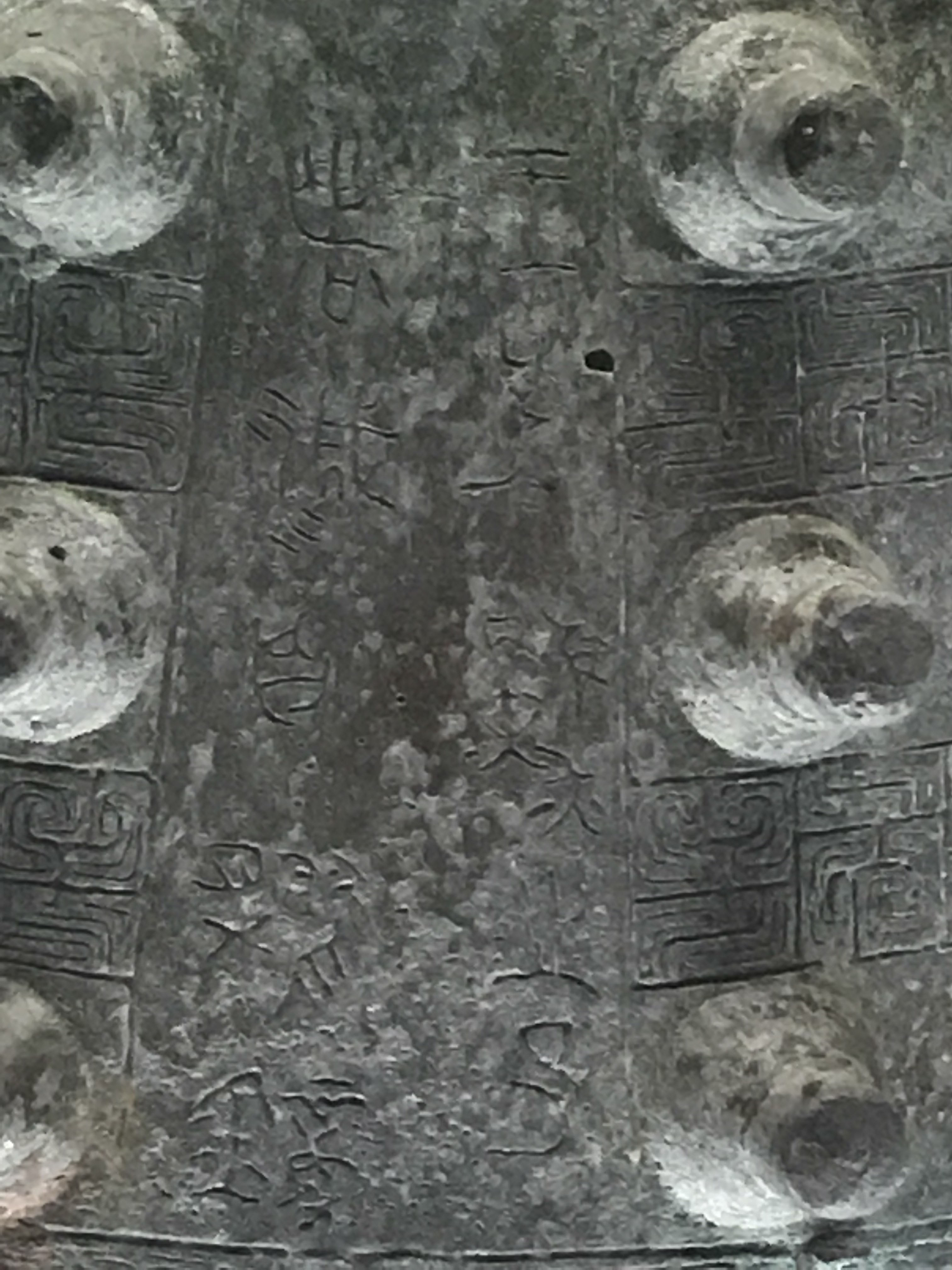
| | The Zhejian Bell from the Shanghai Museum, this part of the inscription reads 王皮㸐之子/者減自鐘. |
**10. Bell of Prince Zhejian 者减鐘 (Jicheng 集成, 1.202).
Provenance: Qianlong 乾隆 year 26 (1761); Linjiang 臨江, Jiangxi (present-day Qingjiang County 清江縣)
Current Location: Shanghai Museum上海博物館
Name of Artifact Used in Previous Studies:
Kaogu 考古 (1979.1): 63, illus. #2.
者减鐘十, Jicheng 集成, 1.202.
者减鐘, Dong Chuping 董楚平 (1992), 26-39.
者鐘, Shi Xiejie 施謝捷 (1998), #10, 527.
工䱷王皮[難 over 灬]之子者[減 over 皿]鐘, Dong Shan 董珊 (2014), #69A-B.
Inscription:
Jicheng (Chant.org): 隹正月初吉丁亥。工䱷王皮㸐之子者減自鐘。子子孫孫。永保用之。
Shi (1998): 隹正月初吉丁亥,工䱷/王皮㸐之子/者減自[???]鐘,/子=孫=永保用之。
|
|
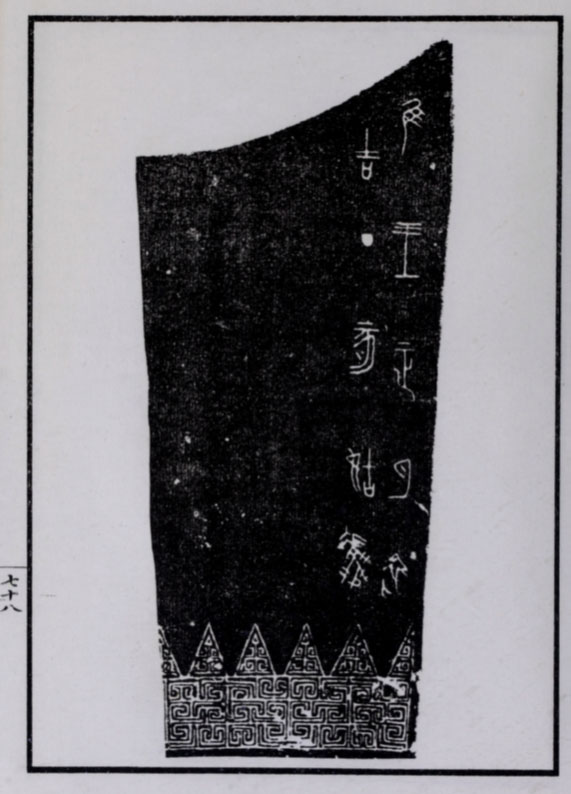
| | The Goudiao-bell of the son of Gufeng Guatong from Zhou Jinwen cun 周金文存: 6卷: 1.78. |
1788
The Goudiao-bell of the son of Gufeng Guatong 姑馮𠯑同之子句鑃 (集成, 2.424)
Found in Changshu County, Jiangsu in 1788.
Current Location: Unknown
Name of Artifact Used in Previous Studies:
Zou An 鄒安, Zhou Jinwen cun 周金文存: 6卷: 1.78-79.
姑馮𠯑同之子句鑃, Jicheng 集成, 2.424.
姑馮句鑃, Dong Chuping (1992), 152-156.
姑馮𠯑同之子句鑃, Shi Xiejie 施謝捷 (1998), #117, 567-8.
姑馮同句鑃, , Dong Shan 董珊 (2014), #188,84n4.
Inscription:
Jicheng (Chant.org): 隹王正月初吉丁亥。姑馮𠯑同之子。擇厥吉金。自乍商句鑃。厶樂賓客。及我父。子子孫孫。永保用之。
Dong (1992): 隹王正月初/吉丁亥, 姑囗[仌+鳳](馮)/𠯑同之子/囗[???](擇) 囗[???]/吉金,自/乍(作)商句鑃, 㠯(以)/樂賓客及/我父囗[???](兄),子=/孫=永保用之。
Shi (1998): 隹(唯)王正月初/吉丁亥, 姑馮(?)/𠯑同之子/𢍰 (擇) 氒(厥)吉金,自/乍(作)商句鑃, 㠯(以)/樂賓客,及/我父囗[???](兄),子=/孫=永保用之。
Dong Shan (2014): 隹(唯)王正月初吉丁亥, 姑馮𠯑同之子擇氒厥吉金(厥)吉金,自乍(作)商句鑃,以樂賓客,及我父兄,子子孫孫,永保用之。
|
1856-1875
Jian of King Fuchai of Wu 吳王夫差鑑 (集成, 16.10296).
Provenance: Unearthed during the Tongzhi reign 同治 (1856-1875), in Mengwang village 蒙王村, in Daizhou 代州 (Present day Shanxi 山西). In a private collection in Beijing 北京莫氏曾藏 in the 1930s.
Current Location: Whereabouts unknown
Name of Artifact Used in Previous Studies:
吳王夫差鑑 (Jicheng 集成, 16.10296)
吳王夫差鑑一, Shi Xiejie 施謝捷 (1998), #30, 535-6.
攻吳王夫差鑑, Dong Shan 董珊 (2014), #43.
Inscription:
Jicheng: 攻吳王大差擇厥吉金。自乍御監。
Shi (1998): 攻吳王大(夫)差擇氒(厥)吉金。自乍(作)御監(鑑)。
Dong Shan (2014): 攻吳王大(夫)差擇氒(厥)吉金。自乍(作)御監(鑑)。
|
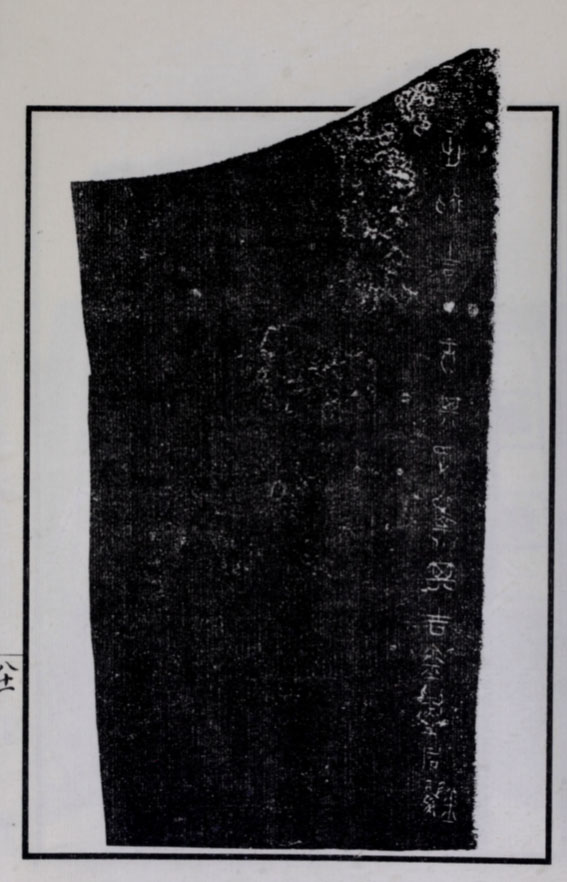
| | The Qici Goudiao-bell 其次句鑃 from Zhou Jinwen cun 周金文存: 6卷: 1.81. |
1. The Qici Goudiao-bell 其次句鑃 (集成, 2.422).
Provenance From a mountain in Wukang County 武康縣, Zhejiang.
Current Location: Palace Museum 故宮博物院, Beijing.
Name of Artifact Used in Previous Studies:
Zou An 鄒安, Zhou Jinwen cun 周金文存: 6卷: 1.81.
其次句鑃, Jicheng 集成, 2.422.
其次句鑃, Dong Chuping (1992), 156-161.
其次句鑃一, Shi Xiejie 施謝捷 (1998), #118, 568.
其次句鑃乙, Dong Shan 董珊 (2014), #190,86n3.
Inscription:
Jicheng (Chant.org): 隹正初吉丁亥。其次擇其吉金。鑄句鑃。台亯台孝。用𣄨萬壽。子子孫孫。永保用之。
Dong (1992): 隹正初吉丁亥, 其次𢍰其吉金, 鑄句鑃, 台(以) 享台(以)孝, 用𣄨(祈)萬壽,子=孫=, 永保用之。
Shi (1998): 囗正初吉丁亥,其次𢍰(擇)其吉金鑄句鑃。.台(以) 亯(享)台(以)孝(孝)。用𣄨(旗 – 祈)萬壽。子=孫=永保用之。
Dong Shan (2014): 隹正初吉丁亥,其次擇其吉金鑄句鑃。台(以)享(享)台(以)孝(孝)。用祈萬壽。子子孫孫。永保用之。
|
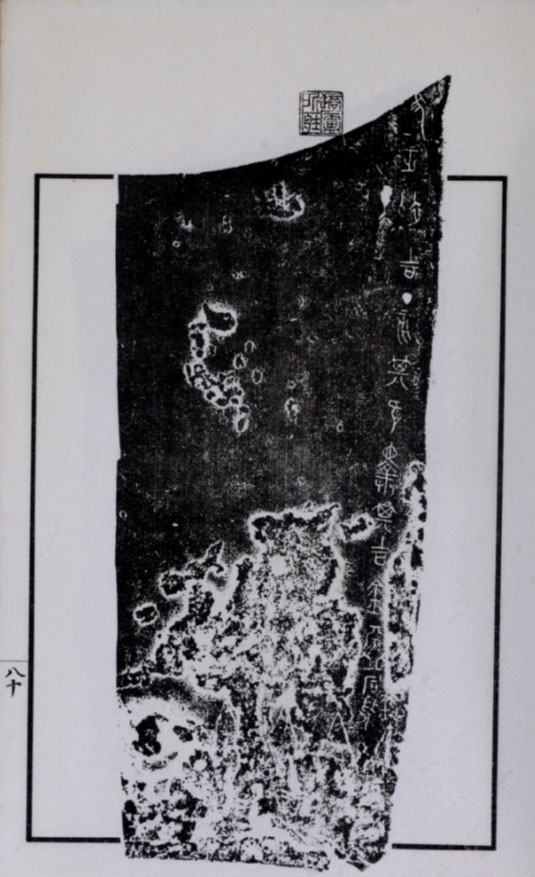
| | The Qici Goudiao bell 其次句鑃 from Zhou Jinwen cun 周金文存: 6卷: 1.80. |
2. The Qici Goudiao bell 其次句鑃 (集成, 2.421).
Provenance From a mountain in Wukang County 武康縣, Zhejiang.
Current Location: Current whereabouts unknown. Originally in the collection of Su Huanong 蘇花農 and Xu Zishan 徐紫珊.
Name of Artifact Used in Previous Studies:
Zou An 鄒安, Zhou Jinwen cun 周金文存: 6卷: 1.80
其次句鑃, Jicheng 集成, 2.421
其次句鑃 Dong Chuping (1992), 156-161.
其次句鑃二, Shi Xiejie 施謝捷 (1998), #119, 568-9.
其次句鑃甲, Dong Shan 董珊 (2014), #189,86-7n1.
Inscription:
Dong (1992): 隹正初吉丁亥, 其次𢍰其吉金, 鑄句鑃, 台(以) 享台(以)孝, 用𣄨(祈)萬壽,子=孫=, 永保用之。
Shi (1998): 隹(唯)正初吉丁亥,其次𢍰(擇)其吉金鑄句鑃。.台(以) 亯(享)台(以)孝(孝)。用𣄨(旗 – 祈)萬壽。子=孫=永保用之。
Dong Shan (2014): 隹正初吉丁亥,其次擇其吉金鑄句鑃。台(以) 亯(享)台(以)孝(孝)。用祈萬壽。子子孫孫。永保用之。
|
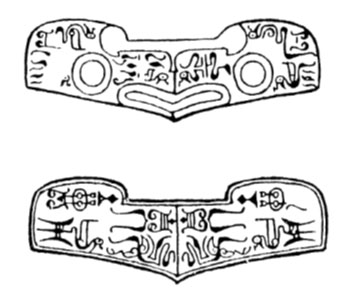
| | The Sword of King Zhougou of Yue 戉王州句劍 |
1881
The Sword of King Zhougou of Yue 戉王州句劍 (集成, 18.11622).
Bought by Wang Yirong 王懿榮 in Xi’an 西安, Shaanxi in 1881.
Current Location: Palace Museum 故宮博物院, Beijing.
Originally in the collection of Wang Yirong 王懿榮 (1845–1900), 陶祖光 Tao Zuguang (1882-1956), and Huang Jun 黃濬 (1890-1937).
Name of Artifact Used in Previous Studies:
Wang Yirong 王懿榮: Tianrangge zaji 天壤閣雜記, 1.239a-b Just description
Zou An 鄒安, Zhou Jinwen cun 周金文存: 6卷: 6.105.3-6.106.2
Luo Zhenyu 羅振玉 (1931), 貞松堂集古遺文 12.23.3-4.
Ancient Chinese Sword with “Bird Script,” Perceval Yetts (1934): Figure 2-3.
越王州勾劍, Rong Geng 容庚 (1964), 281; 302, illus. #11.
戉王州句劍, Jicheng 集成, 18.11622.
越王州句劍 (其五), Dong Chuping 董楚平 (1992), 242.
戉王州句劍 (三), Zhang Guangyu 張光裕 and Cao Jinyan 曹錦炎 (1994), #88, 254.
越王州句劍 (5), Dong Chuping 董楚平 (1998), 119.
越王州句劍三, Shi Xiejie 施謝捷 (1998), #148, 577.
戉王州句劍 (三), Lin Chin-Chung 林進忠 (2007), 23, #88.
越王州句劍十, Wang Jiehua 王結華, et alia (2010), 15.
越王州句劍四, Cao Jinyan 曹錦炎 (2014), 106, 108, illus. #80.
越王州句劍, Dong Shan 董珊 (2014), #104,54-5n1.
Inscription:
Shi (1998): Recto: 戉(越)王州句州句
Verso: 自乍(作)用僉(劍) 自乍用僉(劍)
Cao (2014): Recto: 戉(越)王州句州句
Verso: 自乍(作)用僉(劍) 自乍用僉(劍)
Dong Shan (2014): Recto: 戉(越)王州句·州句
Verso: 自乍(作)用僉(劍) ·自乍用僉(劍)
Translation:
“King Zhougou of Yue made this sword for his own personal use.” 戉(越)王州句,州句自乍(作)用僉(劍) 自乍用僉(劍)
Description by Wang Yirong 王懿荣 (1845~1900), Tianrangge zaji 天壤閣雜記, 1.8a:
辛巳年八月,由川北上,回京館試,到陝西,初見楊估實齋,為陜巨指矣.先是,過寶雞渡河,禱於寶雞祠陳寶之神,願得古器,
門未啓,叩於外,到長安,得楊估彝一中有犧形尤佳,方鼎一,小鼎一,觚一,小蘇估劍一,當為天下第一,烏形陽文篆,如花如字,
字下又有花,鋒如新,馬氏殿當瓦一,古泉、古印不具數,陳寶之神所佑也,望空謝之.楊估為清卿,寄古泉百餘方,佳者纍纍,
興定寶鈔銅板,乃絕品.馬估得於河南府李姓者,聞又有文選銅板一葉,不知何物何歸
In august of 1881, I was returning from northern Sichuan to the capital for an exam, going north and arriving in Shaanxi,
I first went to see Merchant Yang Shizhai, who is the “thumb” (head honcho) of Shaanxi.
I had crossed the river and passed through Baoji 寶雞 [Shaanxi]. Wishing that I might be able to obtain some ancient artifacts,
I prayed at the temple at Baoji to the Chenbao (Treasures of Chen).
The door was still not open, so I kowtowed from outside. When I got to Chang’an,
I got beast shaped vessel that was particularly stunning, one square ding, one small ding, one hu wine vessel from Merchant Yang.
From Merchant Su, I obtained an ancient sword that might be one of the finest in the world.
It has seal characters with bird forms inscribed in raised relief, that looks like flowers and characters at the same time,
under the characters there are more flower patterns, it is sharp as if it were new...All of this is due to the blessing of the Chenbao,
so I looked up into the sky and expressed to my gratitude to them. Merchant Yang was an incorruptible official, who had over a hundred ancient coins,
piles and piles of pristine ones, he had the copper plates to mint Jin dynasty xingding coins, which can’t be found anywhere else.
Merchant Ma got it from Mr. Li of Henan province, moreover, I heard he had a copper printing plate for a page of the Wenxuan,
I don’t know what it exactly is or who has it now.
|
***4. Yue bell with Odd Characters 越奇字鐘 (集成, 1.155).
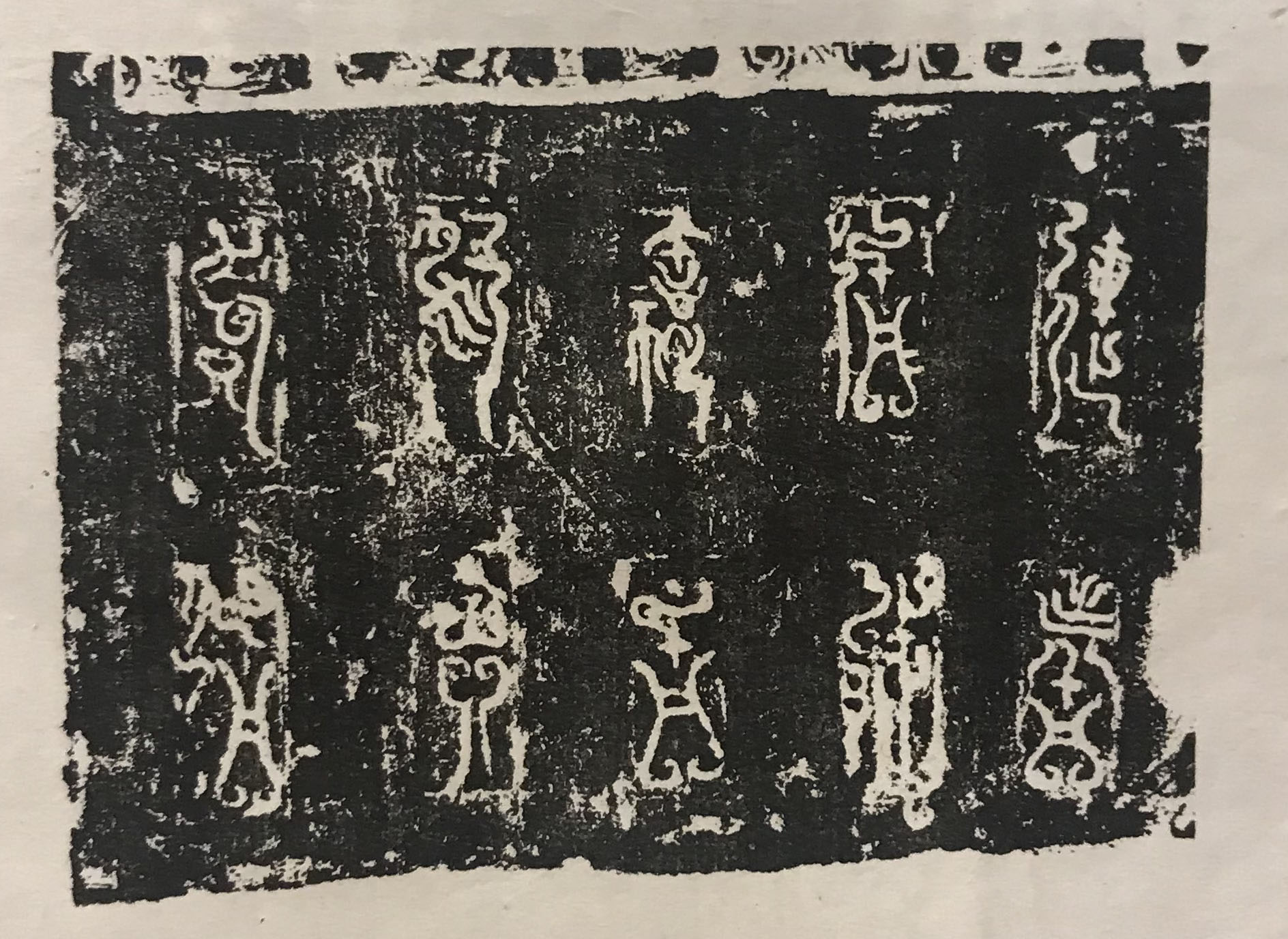
| | Yue Bell with Odd Characters 越奇字鐘 from Zou An 鄒安 (1916), Zhou Jinwen cun 周金文存: 6卷: 1.34b |
Provenance: NP; Linjiang County 臨江縣, Jiangxi (Originally in the collection of Lu Xinyuan 陸心源, Liu Tizhi 劉體智 (1879~1962).
Later kept in Academia Sinica Museum 臺北中央博物館, Taipei).
Current Location: National Palace Museum 臺北故宮博物院, Taipei.
Name of Artifact Used in Previous Studies:
Zou An 鄒安 (1916), Zhou Jinwen cun 周金文存: 6卷: 1.33-35
能原鎛, Jicheng 集成, 1.155.
邾越盟辭鎛甲, Zhang Guangyu 張光裕 and Cao Jinyan 曹錦炎 (1994), #130, 297-301.
越奇字鐘一, Shi Xiejie 施謝捷 (1998), #94, 555 (Shi records that this was only a temprorary name given by Rong Geng).
邾越盟辭鐘一, Cao Jinyan 曹錦炎 (1999), #62, 117-8; 119-20, illus #89.
邾越盟辭鎛甲, Lin Chin-Chung 林進忠 (2007), 25, #130.
越邾营盟辭鎛一, Cao Jinyan 曹錦炎 (2014), 越國器(下)#3, 274-275; 276-7, illus #248.
奇字鎛甲, Dong Shan 董珊 (2014), #191,86n4.
Inscription:
Jicheng (Chant.org): □□之於大□者。連□小。□於□曰利。小者乍心□。衣余者戉□者。利。大□□連者夷。戉禦曰。於余□夷 □□邾□之□□乍夷□
Shi (1998): ⧄⧄/ ⧄/之⧄/⧄乍/居⧄/⧄連水禦□/□□古⧄⧄/可利/之於/⧄□/連者/祈水/⧄於/⧄古/利水/者乍/⧄⧄/⧄余⧄𫑛 ⧄/者利⧄□⧄/連者/居=𫑛/禦古/於余/⧄⧄
Cao (2014): □連小□□/□□□□□/□利/之於/大□/者, 連/□小。/□於/□曰/“利小/者乍(作),/心□,/衣(依)余□囗[枼+阝](越) □/者,利大□□/連者(諸)/尸(夷)。”
囗[枼+阝](越) /禦曰:/隹(唯)余/□尸(夷)/□□。/邾曰/之, □/□者乍(作),/尸(夷) □
Dong Shan (2014): 自連水□□□曰□[子+几],可利之於甚□者連祈水· 自於介曰利水者□· 褱余居𫑛蒥者利[???]□叴,連者居𫑛達曰於余□居,叴□[枼+阝]曰之極□乍居虐。
Dong Shan (2014):To Add
|
***5. Yue Bell with Odd Characters 越奇字鐘 (1890; 集成, 1.156).
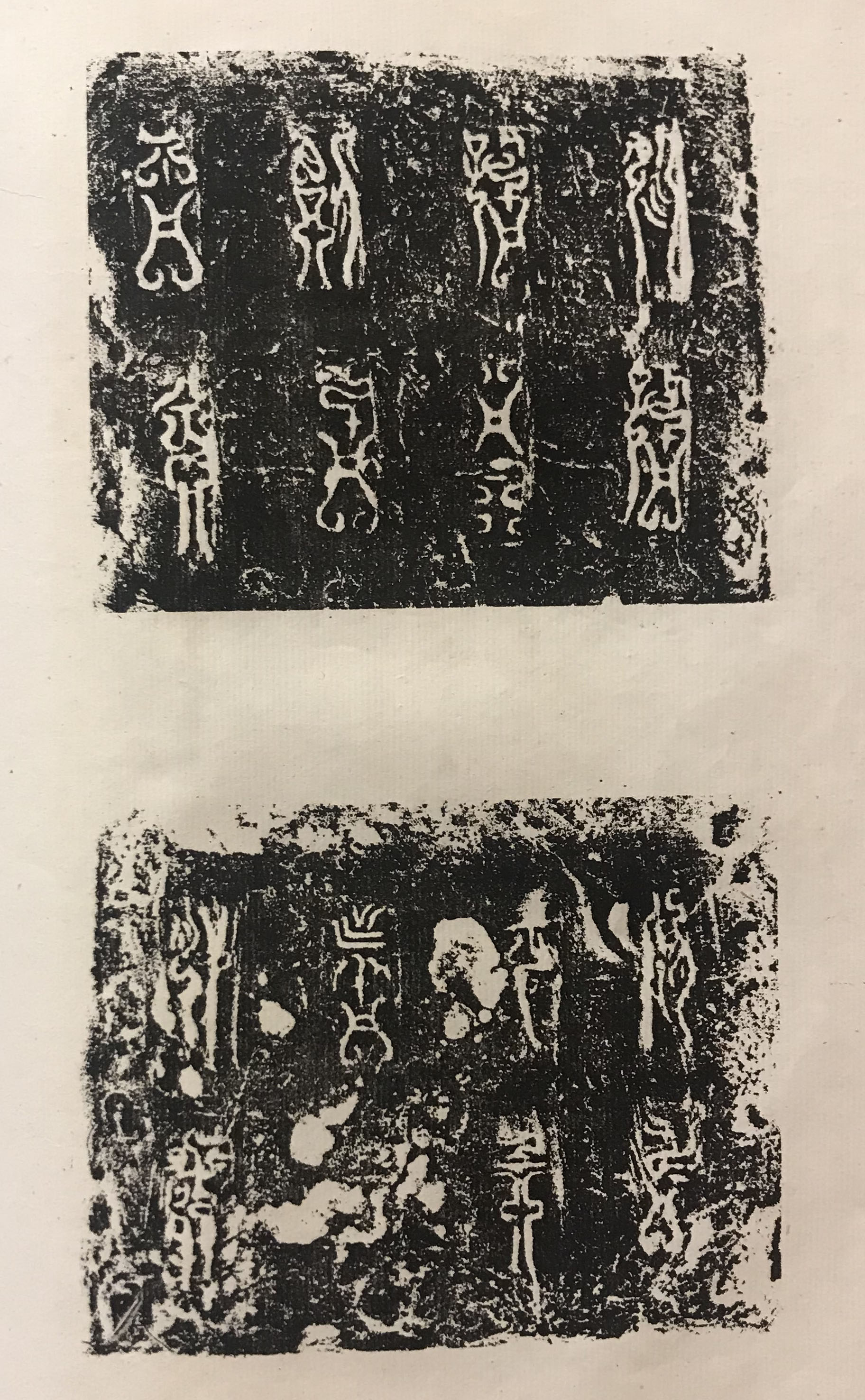
| | Yue Bell with Odd Characters 越奇字鐘 from Zou An 鄒安 (1916), Zhou Jinwen cun 周金文存: 6卷: 1.33-35 |
Provenance: Guangxu, Year 16 (1890), Found by fishermen in Jinjiang 錦江 on the eastern outskirts Ruzhou 瑞州 (Present day Gao’an 高安), Jiangxi (Originally in the collection of Xiong Fangsui 熊方燧).
Current Location: Palace Museum 故宮博物院, Beijing.
Name of Artifact Used in Previous Studies:
Zou An 鄒安 (1916), Zhou Jinwen cun 周金文存: 6卷: 1.45-47.
能原鎛, Jicheng 集成, 1.156.
邾越盟辭鎛乙, Zhang Guangyu 張光裕 and Cao Jinyan 曹錦炎, 1994, #131, 302-5.
越奇字鐘二, Shi Xiejie 施謝捷 (1998), #95, 555-6 (Shi records that this was only a temprorary name given by Rong Geng).
邾越盟辭鐘二, Cao Jinyan 曹錦炎 (1999), #63, 118; 122-3, illus #90.
邾越盟辭鎛乙, Lin Chin-Chung 林進忠 (2007), 25, #130.
越邾营盟辭鎛二, Cao Jinyan 曹錦炎 (2014), 越國器(下)#4, 275, 280; 278-9, illus #249.
奇字鎛乙, Dong Shan 董珊 (2014), #19286n5.
Inscription:
Jicheng: 夷膚甚□者元。乍□曰。自𣄨□曰。□爯勞 曰利。連余大邾。大□之宔戉。曰。余入邦。乍利□小。其者□□□ 於子子。行則曰。自余
Shi (1998): 於⧄/⧄⧄/睗古/⧄余/居膚⧄⧄/者元乍(作) ⧄/⧄⧄/祈⧄/古⧄/⧄⧄/古利 /連余/大囗[枼+阝]/大⧄/之宔戉⧄/余⧄⧄乍/利⧄/水亓/者可/⧄⧄
Cao (2014): 尸(夷)膚(营)甚□/者元乍(作) □/曰: “自/祈□/曰: □/爯(稱)勞/連余/大邾/大□/之宔(主)戉(越)。曰:/余內(入)邦。乍(作)/利□/小, 亓(其)/者□/□□ /於子/子。”行/則曰:/自余/□□□□/□利/之於
Dong Shan (2014): 居膚甚□者元乍□ ·曰自祈□古□蒥勞· 古利連余□ [???]□ [枼+阝] □ [???]麗· 之宔戉自余自蒥乍· 利叴水亓者可肝□ ·於□[子+古]□[子+古]□[八over口]則曰自余
|
***6. Yue bell with Odd Characters 越奇字鐘.
Provenance: NP
Current Location: Whereabouts unknown
Name of Artifact Used in Previous Studies:
鳥篆鐘, Rong Geng (1938), Niaoshu kao buzheng illus. #21
越奇字鐘三, Shi Xiejie 施謝捷 (1998), #96, 556-7; 360-363.
越奇字鐘三, Lin Chin-Chung 林進忠 (2007), 26, 166
越邾营盟辭鐘, Cao Jinyan 曹錦炎 (2014), 越國器(下)#5, 280-4, illus #250.
奇字鐘 , Dong Shan 董珊 (2014), #193,87n2.
Inscription:
Shi (1998): 唯 余 囗[???] ⧄⧄ ⧄ 大 土 ⧄ 立 建 ⧄□ 成 囗[???] 古
Cao (2014): 尸(夷) □/呂(营) 大土/囗[枼+阝](越)立建 /□□/成邾(?),曰/唯余囗[???]盡
Dong Shan (2014):囗囗·越立建城[over木+阝]曰·[辶+占]世·唯余囗(盡)既(概)囗(吳)土。
|
|




